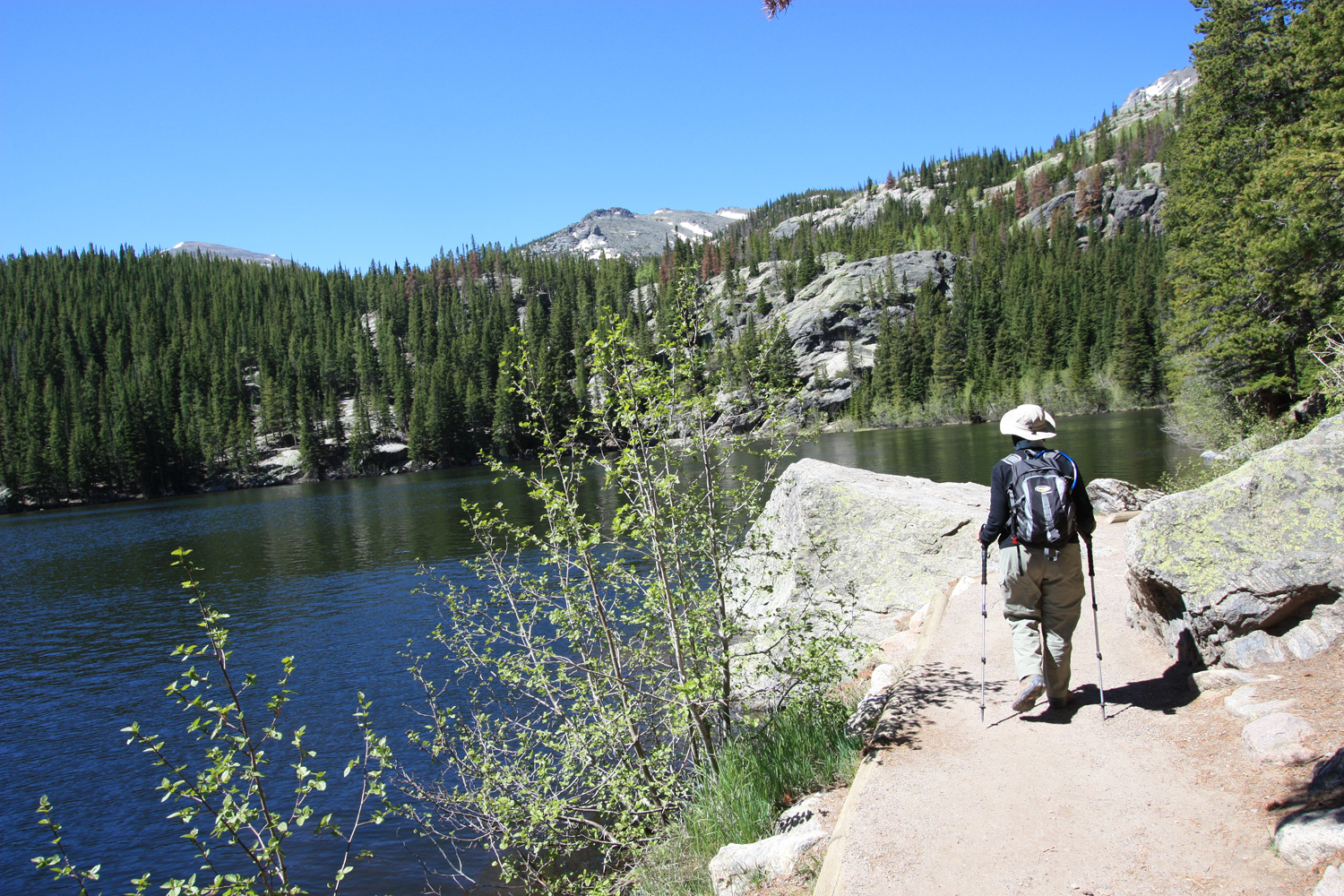Rocky Mountain National Park
Located: Colorado - Established: January 26, 1915
The Park: Welcome to the backbone of America! The 2,700-mile Rocky Mountain chain, stretching from Mexico to Alaska, is the world’s longest mountain barrier. In the southern section of these mountains you’ll find the magnificent Rocky Mountain National Park!
Rocky Mountain High! For an area to be classified as Alpine Country, its elevation must exceed 11,400 feet above sea level. Trees do not grow at this elevation. Breathing can be challenging at this height as well! One third of Rocky Mountain National Park is “alpine” –over 78 peaks exceed the 12,000-foot mark!
Rocky hosts many of Colorado’s 53 “fourteeners” – mountain peaks exceeding 14,000 feet in elevation. Long’s Peak, the park’s highest, measures in at 14,249 feet.
Emerald Lake
The Trail Ridge Road– America’s highest highway – roughly follows a 10,000-year-old hunting trail and crests at 12,183 feet. At the summit of this road, the air is thin and crisp and the view is splendid. A trip to the summit is worth the drive!
Getting there: Rocky is approximately 70 miles northwest of Denver, CO. Estes Park serves as the gateway into the park for those entering the eastern portion of the park. The southwestern entrance to the park is accessed via Hwy 49/34 through Granby, CO.
When to go: Rocky is open all year...weather permitting! Summer and fall are the busiest. If traveling to Rocky during these months, be sure to arrive early and if you plan on camping, make reservations!! Winter access is subject to weather conditions. The west side of the park gets the most snow. Trail Ridge Road closes in winter.
What to do: Rocky hosts two outstanding scenic drives. The 48-mile Trail Ridge Road is considered the “highway to the sky” and will expose you to dramatic views of the Rockies. Plan on at least a half-day to experience this memorable roadway.
The Old Fall River Road is an 11-mile, one-way “motor nature trail” with a posted speed limit of 15 mph! Primarily gravel, the Old Fall River Road will lead you from Horseshoe Park through the park’s wilderness areas to Fall River Pass, almost 12,000 feet above sea level.
Terry trekking along Bear Lake shoreline during our 9th park visit.
Hiking Rocky. Rocky is one of the country’s most popular National Parks and draws hoards of visitors each year. Once you’ve taken the scenic drives, go take a hike on any of the over 350 miles of trails that weave a tapestry of tranquility for those who venture beyond the parking lot.
Many of these trails are located in the wilderness sections of the park; however, the trails originating at Bear Lake are easy to access and lead to beautiful lakes and stunning views.
Where to stay: There are no overnight lodging facilities within the park; however in nearby Estes Park and Grand Lake, there are plenty of options.
As for camping, Rocky has 5 established campgrounds. Four of the campgrounds are open for tent and vehicle camping. One is restricted to tent only. Reservations are strongly recommended when traveling to Rocky in the summer and fall. There are literally hundreds of backcountry campsites scattered throughout the park!
Rocky Mountain Big Horn Sheep
Wildlife: The number one rated activity by park visitors is wildlife viewing. The large population of “megaflora” includes 60 species of mammals and over 280 varieties of birds. Bighorn sheep, black bear, elk, moose, marmot and mountain lions all thrive within Rocky.
Memorable moment: One of our most memorable hikes began at Bear Lake. From there we ventured on up to Dream Lake, Emerald Lake and on to Lake Haiyaha. After eating our lunch at Lake Haiyaha, we trekked on down to Alberta Falls and back to Bear lake. A 10+ mile trek that still stands out as one of our most excellent park experiences!
Banner: View of the Rocky Mountain high lands from atop the Trail Ridge Road. Elevation 12,183 feet above sea level!
Experience these Check List:
- Stop by any of the park's four Visitor Centers
- Drive the Trail Ridge Road
- Explore the Old Falls River Road (one way)
- Hike to Lake Haiyaha via Bear Lake
- Shoot a Bighorn Sheep (with camera!)
- Experience Alberta Falls
Alberta Falls





